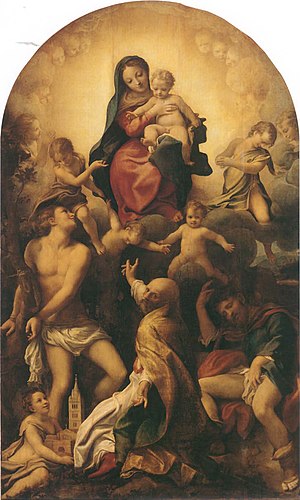The Madonna of Saint Sebastian (Correggio)

|
| The Madonna of Saint Sebastian |
|---|
| Antonio da Correggio , around 1524 |
| Poplar wood |
| 265 × 161 cm |
| Old Masters Picture Gallery |
The painting The Madonna of St. Sebastian von Correggio is owned by the Old Masters Picture Gallery in Dresden .
Image description
“ The Madonna of Heil. Sebastian. Mary with the child appears in clouds to the three saints who are grouped below on the earth, and looks down friendly. On the left the one looks safe. Sebastian, naked except for the loincloth, tied to a tree with both hands, transfigured toward heaven in a lively turn. In the middle he kneels. Bishop Geminianus, looks at the beholder and points up with his right hand at the apparition. An angel holds his landmark, the model of the church, at his feet. On the right, the bare-legged one sleeps soundly. Rochus. Bigger and smaller angels, of which a bigger one denies salvation. Sebastian points out Maria, a smaller cheeky ride on a cloud, have lowered themselves with them. At the very top the angel head glory shines in golden yellow light. "
A Sacra Conversazione is depicted, as in Correggio's painting Madonna of St. Francis , but there are significant differences in the structure of the composition: The depicted events are more complex, the figures are more moving and the viewer is almost drawn by the figure of St. Geminian in the center of the picture urgently requested to turn to the portrayed. This corresponds to the theoretical foundations on the basis of which this work may have been created; so z. B. in the treatise on painting by Leon Battista Alberti (1436) stated:
". . . I would then like that someone in the picture wakes us to participate in what is being done there, be it by inviting us to see with his hand, or by warding us off with an angry face and rolling eyes, or that he opens up a danger, or a wonderful incident, or that he invites you to cry or laugh with him at the same time: so whatever the figures in the picture do with themselves or in relation to you (the beholder), be done accordingly, to emphasize the presented event or to instruct you about the content of it. (P. 122) "
Posse suspects that this picture creation was influenced by Michelangelo , whose ceiling paintings in the Sistine Chapel Correggio could have seen on a trip to Rome in 1518.
The Madonna is depicted here as a figure of light, as the bearer of light, a motif that is often used in Christian iconography , also symbolically, to glorify the Mother of God. These frescoes from a southern German church may be cited as an example:
In the Italian High Renaissance, too, the Madonna and Child was a popular and novel motif as a celestial phenomenon. Examples of this are the Sistine Madonna , the Madonna di Foligno or a work by Antonio Pisanello .
The light emanating from the Madonna and the child as the manifestation of the divine can be said to have a beneficial effect:
- The St. Sebastian , on the left of the screen, does not carry the usual arrows in his immaculate, touched by the light body. Only in the shade, near the tree to which he is tied, could an arrow stick in his body, but this could also be a tree branch.
- The tree to which Sebastian is tied has green leaves.
- Saint Rochus , who sits opposite him, sleeps in the shade, only his legs are demonstratively exposed in the light and show no wound, so that one can assume that the plague sufferer is cured.
Provenance
The picture was painted around 1524 on behalf of the San Sebastiano Rifle Guild for their altar in Modena Cathedral . In 1659 it was acquired by Alfonso IV. D'Este for the ducal gallery in Castello Estense and came from there to the Royal Picture Gallery in Dresden with the purchase of another 99 paintings in 1746.
Web links
Individual evidence
- ↑ Thomas W. Gaethgens and Uwe Fleckner (eds.): History of the classical picture genres in source texts and commentaries, Volume 1, history painting . Scientific Book Society, Darmstadt 2003
- ↑ Hans Posse: The four altar paintings by Antonio da Correggio . Verlag Julius Bard, Berlin and Verlag der Wilhelm und Bertha v. Baensch Foundation, Dresden 1923
- ↑ a b Wolfgang Braunfels (Ed.): Lexicon of Christian Iconography . Scientific Book Society, Darmstadt 2012






